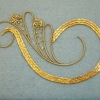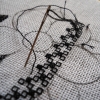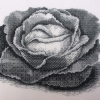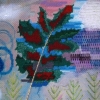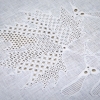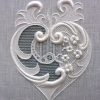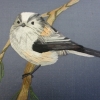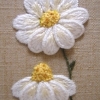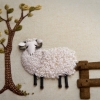Embroidery Techniques
Embroidery is used to embellish fabric. There are many styles of embroidery which can be used to add floral, geometric, or other designs.The wide variety of techniques can be used in traditional and contemporary designs adding detail and focus.
There’s traditional goldwork used for centuries to symbolize wealth and power; delicate whitework for weddings, christenings and formal household linens; crewelwork with the Jacobean style bringing design traditions from Asia; blackwork seen as a costume decoration of status in 16th century portraits and still used today for dramatic effects in portraiture; and numerous other techniques for creative and imaginative use.
Goldwork
Dating back over 1000 years, with its roots in religious and royal embroidery, goldwork has a luxurious and opulent quality. Today, in addition to ecclesiastical, ceremonial and military applications, contemporary goldwork designs are used in the fashion industry and interior design. Goldwork embroidery uses a wide variety of metal threads including gilt copper and silver and can be combined with other techniques such as silk shading to produce sumptuous effects.
Blackwork
This technique involves using intricate patterns which have an almost graphic quality to create an embroidered picture. Blackwork was traditionally used as decoration on caps, collars and cuffs and usually depicted small floral motifs in the repeat design. Both sides of the embroidery were to be seen so it was worked in a double running stitch (also known as Holbein stitch), making the front and back identical.
Blackwork developed in the 20th century and is now used to portray realism and form through differing densities of thread and pattern to create tonal shading.
Using a counted thread technique with a variety of geometric stitches in one colour, dramatic effects are created which are particularly effective with portraits and architectural themes. Blackwork is a very diverse technique and although traditionally worked in black any single colour can be used.
Jacobean Crewelwork
One of the earliest forms of surface stitching, crewelwork uses a range of stitches and elements of shading using crewel wool on linen. Jacobean-style designs, developed in the 17th century were influenced by exotic flora and fauna found on imported Indian chintzes. English embroiderers added insects and quirky animals to the traditional Tree of Life foliage designs. Using two main colors in tonal shades Jacobean embroidery has been popular for centuries but crewelwork stitches also work well with contempary designs.
Introducing a range of stitches and an element of shading, crewelwork is an ideal technique for beginners new to embroidery. Worked in crewel wool on linen, this decorative technique is one of the earliest forms of surface stitching. Basic designs can include between six to ten crewelwork stitches and a range of colors is used for tonal accents.
Canvaswork
Canvas Shading is used to blend colors in a design to create a realistic effect. Canvas Stitches uses a range of stitches and threads (including metal threads) to create depth and movement. Both are worked on an open weave canvas, usually 18 point. Sometimes incorrectly referred to as tapestry, and also known as needlepoint, the use of wool on canvas was traditionally used for seat covers and rugs. It was used in a basic form on medieval vestments and furnishings, but it is really during the second half of the 16th century that canvaswork in its current form became a part of everyday life.
Whitework
The term applies to a variety of techniques ranging from the bold stitches of Mountmellick and Hardanger to the delicate work of Ayrshire and Fine White embroidery. Traditionally worked with white thread on white fabric and used for bridal and christening wear and ecclesiastical embroidery. Whitework techniques adapt well to contemporary designs and the introduction of color.
Ayrshire work – developed in 19th century in Scotland and traditionally used on christening gowns and handkerchiefs using satin stitch, eyelet sand needle lace fillings. You should have some experience of whitework before you attempt this technique.
Broderie Anglaise – a delicate technique using cutwork and satin stitch to achieve lace-like effects. Also called “eyelet” embroidery.
Hardanger – a Norwegian technique traditionally worked on even-weave fabric using counted and drawn thread in geometric “Kloster Blocks” to create patterns.
Mountmellick – an Irish technique worked on firm cotton with matt threads of various thicknesses to produce a textured effect. Ideal for newcomers to whitework.
Drawn thread work – creating stitches on fabric where the warp and/or weft threads have been pulled out to form the foundation of a pattern.
Pulled thread work – the patterns textures are achieved by pulling some threads together and others apart.
Richelieu – a cutwork technique using eyelets and ladders.
Shadow work – the stitches are worked on the reverse side of a transparent fabric to give a shadowed effect when viewed from the right side.
Fine whitework – delicate designs are created on two layers of fine linen with a layer of net in between. The design is worked using a range of stitches and textures before cutting away areas of the linen to facilitate working drawn and pulled thread stitches and net darning patterns. For stitchers experienced in whitework.
Silk Shading
This beautiful technique, sometimes known as “painting with a needle”, uses a number of colors in cotton or silk threads, skillfully blended together to create the natural appearance of a flower, fruit, plant or animal. The technique uses long and short stitches (either in silk or cotton threads or even wool) and the emphasis is on blending color and understanding tonal shade.
Stumpwork (Raised Embroidery)
Stumpwork, also known as raised embroidery uses an array of different materials and embroidery techniques to tell a contemporary story in stitch using three dimensional elements. Techniques include silk work, goldwork, counted work, flat & raised stitching, bead work, padding and needlelace. Stumpwork designs are varied and imaginative offering scope for a high degree of creativeness.


